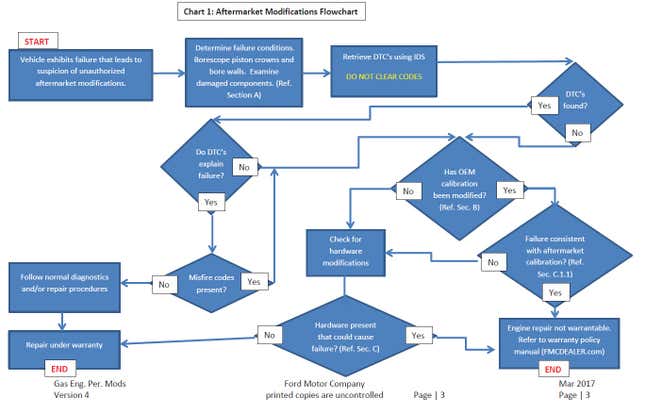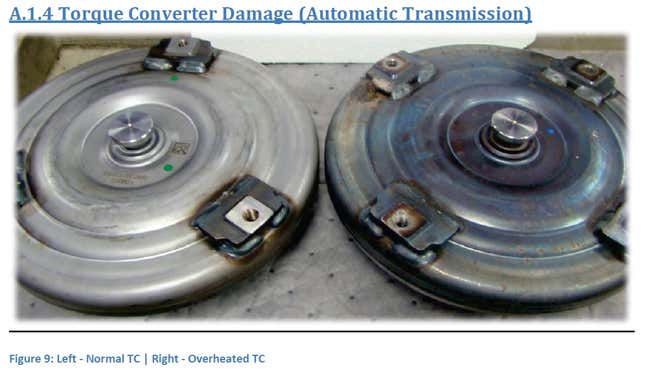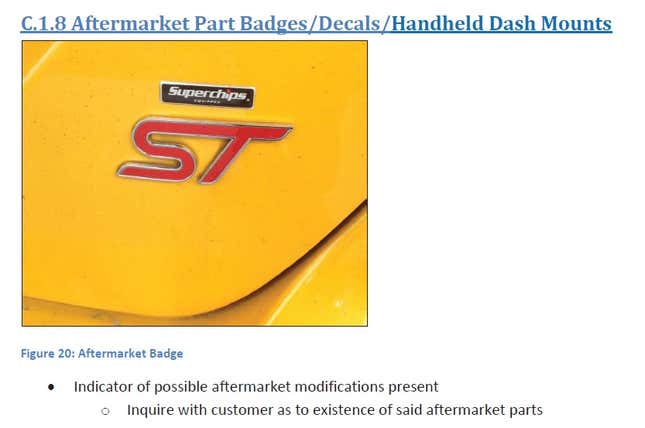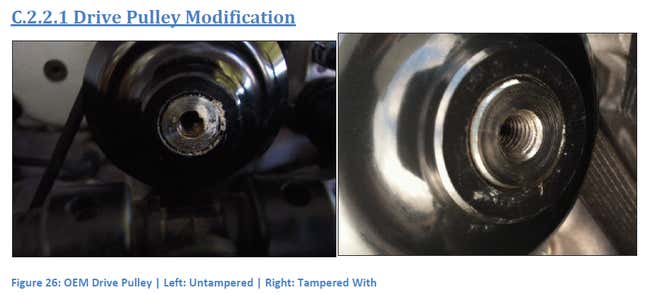
There are equal amounts of fear and bravado when it comes to modifying new cars. Many owners worried they’ll void their warranty don’t modify their car at all. Others make modifications they can reverse if they need to take a car in for warranty work. But few know what a car company even looks for when assessing a modified car with a problem.
The Magnuson-Moss Warranty Act of 1975 helps consumers when it comes to installing aftermarket parts, but only to a certain extent since the manufacturer can still deny coverage if they can prove that the aftermarket part caused the damage.
Going in for a warranty repair if your car is modified can be a stressful affair since the decision of whether the damage caused the modification is often at the whim of the technician diagnosing the car. Luckily, we spotted a document in the Ford service portal that shows us at least how one manufacturer decides what caused the damage and whether they will approve a warranty repair.
The document posted on the Ford service portal and available through some public websites is called “A Guide to Identifying Failures Related to Performance Modifications” as it focuses on identifying potential modification to the gas engines in their performance cars. Ford sells tons of desirable cars for tuners, and it’s no surprise to see a document like this from the company that supplies the public with Fiesta STs and Mustangs.
The guide is interesting, particularly because it shows that Ford is wise to your tricks, tuners. Don’t think Ford hasn’t seen your little plans before. Trying to swap a stock pulley back onto your GT500 will not go unnoticed.
The guide starts off with a simple flow-chart directing the technician to use a borescope to look inside the motor to see if damage is present and to check for related codes. The flow-chart offers a few points from that direction that lead to either a warranty repair or a denial.

Initial Checks Performed By Technicians
The guide starts out with some talking points telling technicians and service advisers to inform owners that current factory approved and certified calibration or tunes are set up for maximum performance for how the cars are built and that aftermarket parts or tunes risk damage to engines and transmissions.
If modifications are suspected, technicians are instructed to record specific diagnostic trouble codes (DTCs) and freeze frame data that would explain why there’s damage to the engine.
This would be stored information relating to misfires, knock, increased catalyst temperature, and lean air-fuel ratios. Looking at these specific parameters makes sense; increasing boost can cause lean fueling conditions, which can cause the engine to knock and then increase the temperature in the catalytic converter as a result of those detonations.
Covered Performance Parts
Now, there are some performance modifications that are approved and covered under a separate warranty through Ford Performance. Those include products from Ford Performance, Ford Racing, and Mountune.
Technicians are instructed to check the OASIS service portal (Online Automotive Service Information System) in order to verify that the parts were installed correctly and to verify warranty information there.

Internal Damage
If a technician suspects that knock damage has occurred, they are instructed to look at the cylinders either by placing a borescope through a spark plug hole or by disassembling the engine if that’s required. They can also check for knock events without tearing into the engine since spark plugs will often show degradation if the engine has experienced detonation.
Some of the things that they’ll look for include scored cylinder walls and broken piston ring lands.
Discovering this type of damage does not necessarily mean that the technician will automatically deny the warranty repair, or even that they’ll conclude that it the engine was modified. One of the possible causes listed for this kind of damage can be simply low quality fuel.
Technicians even check very light modifications, though. Cold air intakes are a fairly common modification and although many do improve performance, some are mounted in a way that can allow the engine to ingest water. Technicians are warned that if they notice that a connecting rod is bent, it’s possible that the engine hydrolocked after ingesting water thanks to an aftermarket intake. They also note that overboost conditions can result in excessive cylinder pressure and bend a rod, as well.

Transmission Damage
The next section covers transmission damage and instructs technicians to look for heat spots on torque converters. These are signs of increased power and torque being applied to them. Ford also notes that the clutches inside automatic transmissions can become discolored or cracked in those scenarios.
Ford also calls out twisted driveshafts, caused by launching a car with more power and technicians are even instructed to look inside the wheel to see if any rubber is built up from using soft-compound race tires.
Checking For A Reflash
The IDS (Integrated Diagnostic System) software that Ford technicians use for diagnostic has a few features built into to detect if the car’s software itself has been modified. One such feature is called the ignition counter, which records the number of engine starts since the engine computer was last reflashed. This number should be fairly high for any unmodified car, but it resets to zero when an aftermarket tune is flashed.

Commonly Found Modifications
The last section shows examples of commonly modified intake parts and spacers from brands like Steeda and Forge. It also covers modifications to the PCV (positive crankcase ventilation) system such as new catch cans or vents, explaining that such modifications can cause damage to a car’s turbocharger.
Overdrive pulleys, which speed up a supercharger, are also mentioned. They can cause overboost conditions since they spin faster than the OEM parts. Technicians are instructed to examine the pulley bolt for signs of tampering which could cause suspicion even if the stock part has been swapped back onto the car.
Since the high pressure fuel system in Ford’s EcoBoost engines will not support much additional fuel flow on its own, tuners may add an additional fuel injection source. Ford instructs technicians to look for additional injectors in the induction system. Nitrous oxide systems are also called out with tell-tale signs listed as showing holes in the trunk for the bottle bracket or extra wiring or lines running to the engine bay.

Don’t Put Stickers On Your Car
One of the easiest to spot signs listed in the document is decals. Technicians are instructed to look for decals or badges that name an aftermarket parts company. Even if it didn’t look tacky to sticker up your car, this should be reason enough to avoid it. In addition to the decals, technicians are also instructed to look for dash mounts which could be used to mount an aftermarket tuner, but Ford notes that a technician should verify the purpose of any mount with the owner.
The last section relating to EcoBoost engines covers common turbo modifications such as blow-off valves, wastegates, and downpipes. These modifications can get you more power (and sweet, sweet turbo noises -ed.), but they cause compressor surge or over-speed the turbo. Technicians are instructed to look for them if the engine’s turbocharger has failed.

Supercharged Cars
Supercharged cars such as the Mustang Shelby GT500 have their own section, perhaps unsurprisingly. Pulley upgrades are pretty common for getting more boost and power out of a supercharger setup, and they appear easy to reverse. But be warned: Putting the stock pulley back on for warranty work may not save you. Ford notes that the supercharger shaft is often marked with a white anti-tamper compound and swapping pulleys will leave marks giving away that a modification may have been present at some point. Technicians are also instructed to look for gall marks on the face of the pulley since they may indicated that a puller or installation tool has been used on it.
In general, swapping the stock parts back on the car for warranty work seems to be somewhat of a fruitless endeavor as most of the time technicians can tell that something has been removed and reinstalled.
Overall, this guide from Ford seems to be pretty fair. It requires multiple confirmations for most of the failure modes and deep diagnostics before a technician can decide that an aftermarket part has caused a failure.
It is also important to note that many of these failures can be isolated, so even if a technician determines that one part may no longer be covered by the warranty because of a modification, the rest of your car is still likely covered unless they can prove that the issues are somehow linked.
More on car warranties from G/O Media’s partner:
Jalopnik is not involved in creating these articles but may receive a commission from purchases through its content.
Guide to Manufacturer Car Warranties
Ford Extended Car Warranties
Top Auto Warranty Providers
Best Extended Vehicle Warranties